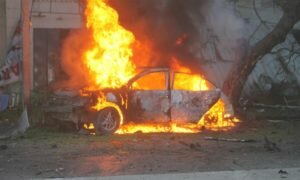 WASHINGTON — Amid its escalating campaign of drone strikes in Somalia, the Pentagon has presented the White House with an operational plan that envisions at least two more years of combat against Islamist militants there, according to American officials familiar with internal deliberations.
WASHINGTON — Amid its escalating campaign of drone strikes in Somalia, the Pentagon has presented the White House with an operational plan that envisions at least two more years of combat against Islamist militants there, according to American officials familiar with internal deliberations.
The proposed plan for Somalia would be the first under new rules quietly signed by President Trump in October for counterterrorism operations outside conventional war zones. The American military has carried out about 30 airstrikes in Somalia this year, twice as many as in 2016. Nearly all have come since June, including a Nov. 21 bombing that killed over 100 suspected militants at a Shabab training camp.
In a sign that the Defense Department does not envision a quick end to the deepening war in Somalia against the Shabab and the Islamic State, the proposed plan is said to include an exemption to a rule in Mr. Trump’s guidelines requiring annual vetting by staff from other agencies — including diplomats and intelligence officials — of operational plans for certain countries.
Instead, the Pentagon wants to wait 24 months before reviewing how the Somalia plan is working, according to the officials, who spoke on condition of anonymity to discuss sensitive matters. Moreover, they said, the Defense Department wants to conduct that review internally, without involvement from other agencies — a request that would further a Trump-era pattern of giving the Pentagon greater latitude and autonomy.
Luke Hartig, a senior director for counterterrorism at the White House National Security Council during the Obama administration, said he supported delegating some greater authority to the Pentagon over such matters, but found it “problematic” that the military wanted to be unleashed for so long without broader oversight.
“A ton can happen in 24 months, particularly in the world of counterterrorism and when we’re talking about a volatile situation on the ground, like we have in Somalia with government formation issues and famine issues,” he said. “That’s an eternity.”
The Defense Department has submitted the plan to the National Security Council for approval by other agencies. Representatives for Defense Secretary Jim Mattis and for the council declined to comment on the details, other than to stress that the military took seriously its need to mitigate or prevent killings of civilian bystanders.
“We are not going to broadcast our targeting policies to the terrorists that threaten us, but we will say in general that our counterterrorism policies continue to reflect our values as a nation,” said Marc Raimondi, a National Security Council spokesman. “The United States will continue to take extraordinary care to mitigate civilian casualties, while addressing military necessity in defeating our enemy.”
Approving the plan would also end the special authority that Mr. Trump bestowed on the top State Department official for Somalia to pause the military’s offensive operations in that country if he saw problems emerging, the officials said. The Pentagon has objected to that arrangement as an infringement on the chain of command, the officials said, and the new plan would drop it — further eroding State Department influence in the Trump administration.
Still, eliminating the State Department authority might make little difference in practice, said Joshua A. Geltzer, who was senior director for counterterrorism at the National Security Council during the Obama administration. Either way, he said, if the State Department wanted to stop airstrikes in Somalia and the Pentagon wanted to keep going, the dispute would be resolved in a meeting of top leaders convened by Mr. Trump’s national security adviser, Lt. Gen. H. R. McMaster.

Defense Secretary Jim Mattis, left, and the head of the United States Africa Command, Gen. Thomas D. Waldhauser, in April. Although the Trump administration gave him flexibility to depart from a rule designed to protect civilians during military operations in much of Somalia, General Waldhauser has avoided using the looser standards. Credit Jonathan Ernst/Agence France-Presse — Getty Images
“The question of whether to allow a veto has been a source of tension before,” Mr. Geltzer said of the State Department authority. “But it’s not clear to me how much it’s worth fighting over — so long as those channels for communicating and working out concerns are functioning.”
According to the officials familiar with it, the Pentagon plan would also exempt operations in Somalia from another default rule in Mr. Trump’s guidelines: that airstrikes be allowed only when officials have determined there is a near certainty that no civilians will be killed. Instead, the officials said, the plan calls for imposing a lower standard: reasonable certainty that no bystanders will die.
However, it is also not clear whether altering that standard would result in any changes on the ground in Somalia. Mr. Trump has already approved declaring much of Somalia an “area of active hostilities,” a designation for places where war zone targeting rules apply, under an Obama-era system for such operations that Mr. Trump has since replaced. That designation exempted targeting decisions in that region from a similar “near-certainty” rule aimed at protecting civilians and instead substituted the looser battlefield standards.
Nevertheless, the head of the United States Africa Command, Gen. Thomas D. Waldhauser, decided not to use that added flexibility and instead kept the near-certainty standard in place. His decision stemmed from the challenges of distinguishing fighters from civilians from the air in Somalia, a failed state with complex clan dynamics and where a famine has uprooted people, many of them armed, in search of food and water.
Robyn Mack, a spokeswoman for General Waldhauser, declined to say whether he would again decide to keep the near-certainty standard in place if the Pentagon’s new plan were approved, writing in an email that it would be “inappropriate for Africom to speculate on future policy decisions.”
However, asked whether General Waldhauser is still imposing the near-certainty standard for strikes in Somalia, she invoked his comments at a Pentagon news conference in March, while the White House was still weighing whether to designate Somalia as an active-hostilities zone, saying what he said then “still stands.” General Waldhauser said then that he did not want to turn Somalia into a “free-fire zone,” adding, “We have to make sure that the levels of certainty that have been there previously, those are not changed.”
Ms. Mack wrote that “it is very important for Africom to have a level of certainty that mitigates or eliminates civilian casualties with our strike operations.”
Mr. Trump’s rules, which have been described by officials familiar with them even though the administration has not made them public, are called the “P.S.P.,” for principles, standards and procedures. They removed several limits that President Barack Obama imposed in 2013 on drone strikes and commando raids in places away from the more conventional war zones that the government labels “areas of active hostilities.”
Among other things, Mr. Trump dropped requirements in Mr. Obama’s rules — called the “P.P.G.,” for presidential policy guidance — for interagency vetting before each offensive strike and determinations that each person targeted pose a specific threat to Americans.
Instead, under Mr. Trump’s guidelines, permissible targets include any member of Al Qaeda, the Taliban, the Islamic State or any other terrorist group deemed to fall under the 2001 congressional authorization to use military force against the perpetrators of the Sept. 11 attacks, even if they are mere foot soldiers who pose no specific threat on their own.
Moreover, instead of interagency vetting before each strike, Mr. Trump’s guidelines call for agencies to approve an operational plan for particular countries, after which the military (or the C.I.A., which also operates armed drones in several countries) may carry out strikes without first getting approval from higher-ranking officials.


 Somali News12 hours ago
Somali News12 hours ago
 Diaspora13 hours ago
Diaspora13 hours ago
 Diaspora12 hours ago
Diaspora12 hours ago
 Briefing Room13 hours ago
Briefing Room13 hours ago
 Briefing Room13 hours ago
Briefing Room13 hours ago
 Somali News2 days ago
Somali News2 days ago
 Terrorism Watch13 hours ago
Terrorism Watch13 hours ago
 Somali News23 hours ago
Somali News23 hours ago











 In 2017, Somalia elected a new president as it battled severe drought and a resurgent al-Shabab. In October, the worst terror attack in the country’s history killed more than 500 people. Meanwhile, the U.S. military is ramping up its military operations as the African Union draws down its 10-year-old peacekeeping mission. From Nairobi, Jill Craig has more.
In 2017, Somalia elected a new president as it battled severe drought and a resurgent al-Shabab. In October, the worst terror attack in the country’s history killed more than 500 people. Meanwhile, the U.S. military is ramping up its military operations as the African Union draws down its 10-year-old peacekeeping mission. From Nairobi, Jill Craig has more.










You must be logged in to post a comment Login